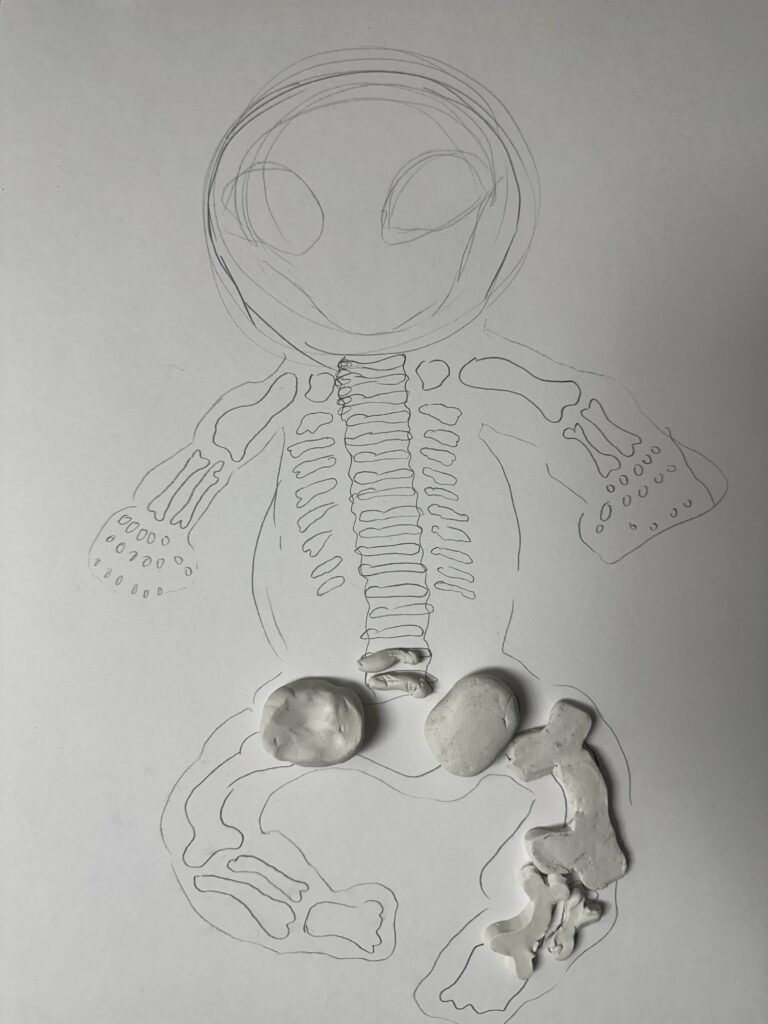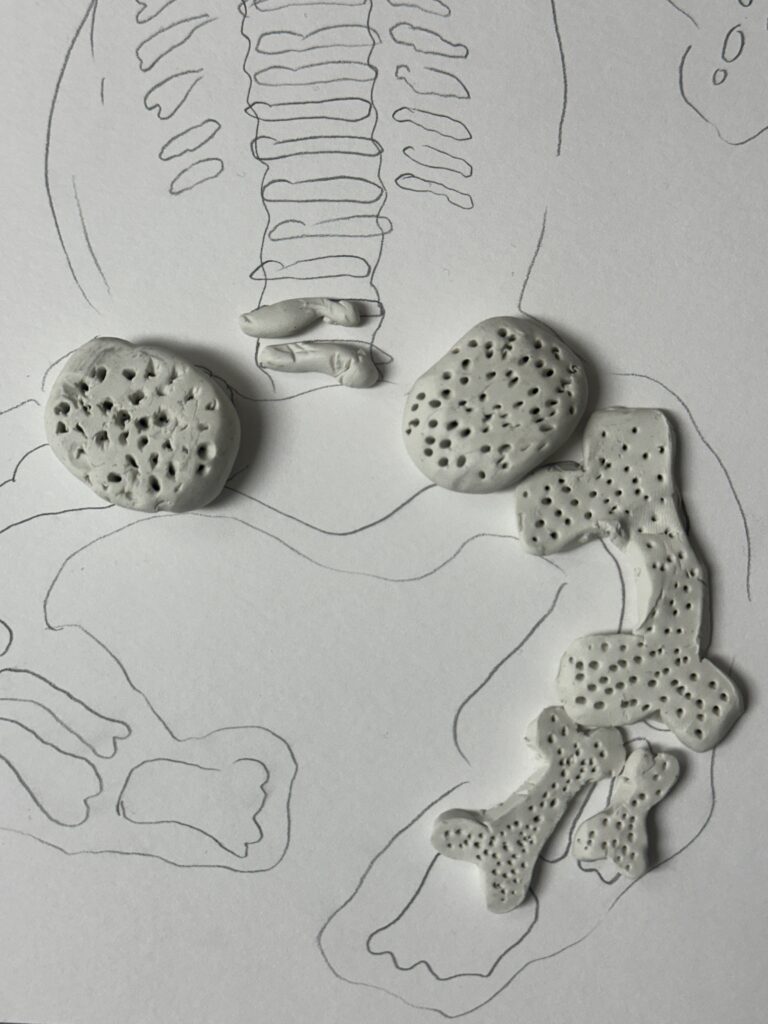

Growing old is a shared event amongst everyone. Including animals, plants, materialistic items, and of course humans. When humans grow old we change and do things like develop wrinkles, gray hairs, and for some maybe even thinning of the hair. While our outer appearance changes, our inner systems begin to change as well. This can all depend on lifestyle choices, family history, and sometimes things can just happen. Our breathing and heart rate begin to slow, our eyesight may get worse, and due to certain medications we may have higher risks associated with falling. Along with the slowing or an imbalance in the bone remodeling process. In an article written by the Center for Bone and Joint Surgery, it states that with aging, the body begins to produce less new bone, this leads to a decrease in bone mass. According to an article written by RadiologyInfo.org, “this is called osteoporosis, meaning “porous bone”. To imagine what osteoporosis looks like, you can think of a honeycomb looking like a healthy bone, but if you imagine the spaces of the honeycomb being larger and the honeycomb losing mass and structure.” (paragraph 1). Osteoporosis is when bones become fragile, weak, and brittle. Osteoporosis is common and affects about 50 million people in the US. It is most seeable in adults over 50 years and over. It is higher in women being 19.6% while in men it is 4.4%. (Cleveland Clinic paragraph 5).
However, think about how this can feel as a younger person, someone even as young as a fetus in the womb. This is called Osteogenesis Imperfecta also called OI. An article written by the Cleveland Clinic states that OI is extremely rare and affects 1 in 20,000 people worldwide. (paragraph 10). This can also be called brittle bone disease. MedlinePlus wrote an article that talks about a couple of different things that can occur due to OI, besides fractures in utero. If the baby survives past birth things like bone deformities (bone deformities can also be seeable while in utero), pain in the bones, blue or gray sclera (whites of the eye), easily bruising, hearing loss, loose joints, and even difficulty breathing can occur. In an article on the Radiopaedia written by Tariq Walizai, osteogenesis imperfecta (OI) refers to a heterogenous group of non-sex-linked, congenital, genetic disorders of collagen type I production (specifically COL1A1 and COL1A2). This involves the connective tissue and the bones (paragraph.1).
In a peer reviewed article titled ‘Assessment of health-related quality of life in children with OI’ it is written that collagen is an essential building block of the body and contributes to the strength and elasticity of skin, tendons, cartilage, and the bones. OI affects the formation of collagen, which then affects bone formation. Bones are composed of a type of complex that involves strands of cross-linked collagen. It is then produced by chondrocytes in newly forming bones. Osteoblast, the builders of the bones add the mineral matrix (calcium salts). This forms the complex with the collagen creating the bone. Children with OI do not produce the needed collagen molecules that will allow for a strong, well organized structure. There are four main types of OI, type I, II, III, and IV. People with type I will have lower amounts of normal collagen than people without OI. People with types II, III, and IV will have improperly formed collagen along with more severe symptoms. An article written by Michael Parfitt, titled ‘What is Bone Mineralization?’ states that the bone formation process can be split up into two stages, the matrix forms and then about two weeks later, mineralization occurs. This process delays in adults, due to the slowing of the body systems that occur with aging, that was mentioned earlier.
The peer reviewed article,called ‘National Trends in Inpatient Hospital Outcomes of Children with osteogenesis Imperfecta and the importance of Extraskeletal Manifestations: A kids Inpatient Database Study’, in this study a couple of things were found. They observed that one of the biggest complications found in children that presented with OI were predominantly respiratory complications. It was also found that children with OI created a significant financial burden for parents and families!
In an article titled, ‘Mortality and Causes of Death in Patients with Osteogenesis Imperfecta: A register-Based Nationwide Cohort Study’. The overall summary was that patients with OI had a higher risk of death due to trauma, respiratory diseases, and gastrointestinal diseases. The group that conducted this study did not have enough information about the phenotype and genotype of the patients. Depending on the type of OI someone is diagnosed with, a long and fulfilling life is possible!
References:
Peer Reviewed Sources
Nielsen, C., Reichenbach, R., Merrell, D., Irwin, C., Hamdy, R. C., & Belthur, M. V. (2024). National Trends in Inpatient Hospital Outcomes of Children with Osteogenesis Imperfecta and the Importance of Extraskeletal Manifestations: A Kids’ Inpatient Database Study. The Journal of Pediatrics, 274, 114174. https://doi-org.uaf.idm.oclc.org/10.1016/j.jpeds.2024.114174
Does osteoporosis cause pain even without a fracture? (n.d.). EBSCO Discovery Service. https://research-ebsco-com.uaf.idm.oclc.org/c/qg64q2/search/details/rpohm5bbwr?limiters=RV%3AY&q=types+of+bone+fractures&modal=cite-details
Classifications of bones and fractures. (n.d.). https://research-ebsco-com.uaf.idm.oclc.org/c/qg64q2/search/details/m2lpkm2ocv?limiters=RV%3AY%2CFM%3AY&q=classifications+of+bone+fractures&modal=cite-details
Mahmood, N. S., Ibrahim, N. M. N., Riaz, N. M., & Hafeez, N. S. (n.d.). Assessment of health-related quality of life in children with osteogenesis imperfecta (OI). The Professional Medical Journal. https://doi.org/10.29309/tpmj/2024.31.06.8125
Non Peer Reviewed Sources
Osteogenesis imperfecta: MedlinePlus Genetics. (n.d.). https://medlineplus.gov/genetics/condition/osteogenesis-imperfecta/
Bell, D., & Farooq, S. (2010). Osteogenesis imperfecta. Radiopaedia.org. https://doi.org/10.53347/rid-9327
Osteogenesis imperfecta (Brittle bone disease). (2024b, September 10). Cleveland Clinic. https://my.clevelandclinic.org/health/diseases/osteogenesis-imperfecta-brittle-bone-disease
Folkestad, L., Hald, J. D., Canudas‐Romo, V., Gram, J., Hermann, A. P., Langdahl, B., Abrahamsen, B., & Brixen, K. (n.d.). Mortality and causes of death in patients with osteogenesis imperfecta: A Register‐Based Nationwide Cohort Study. Journal of Bone and Mineral Research, 31(12), 2159–2166. https://doi.org/10.1002/jbmr.2895

Review of Mckaylie Luedde’s STEAM Project discussing Osteogenesis Imperfecta
Mckaylie has provided an eloquently worded project description on her topic blended with a creative display so I believe she did a great job. Mckaylie begins discussing changes that come with increasing age such as hair color, wrinkles, slowing systems, and bone density, and how these may affect individuals. She shifts the conversation to the decline of bone density with age which can lead to the development of osteoporosis. McKaylie sets the stage for the main concept of the project Osteogenesis imperfecta. Osteogenesis imperfecta (oi) also known as brittle bone disease is a rare genetic disorder that is a defect in the production of collagen in the COL1A1 and COL1A2 genes. OI snowballs into affecting bone strength, the elasticity within the bones, and connective tissue leading to more complications. There are four types of Osteogenesis Imperfecta which increase in the severity of symptoms with each stage. Despite the physical symptoms such as headaches, respiratory difficulties, hearing loss, and deformities in bones or numerous bone fractions, people diagnosed sometimes do live fulfilling lives.